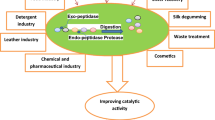Summary
Biotransformations were developed to oxidize Nε-carbobenzoxy(CBZ)-l-lysine and to reduce the product keto acid to l-CBZ-oxylysine. Lysyl oxidase (l-lysine: O2 oxidoreductase, EC 1.4.3.14) from Trichoderma viride was relatively specific for l-lysine and had very low activity with Nε-substituted derivatives. l-Amino acid oxidase (l-amino acid: O2 oxidoreductase [deaminating], EC 1.4.3.2) from Crotalus adamanteus venom had low activity with l-lysine but high activity with Nε-formyl-, t-butyoxycarbonyl(BOC)-, acetyl-, trifluoroacetyl-, or CBZ-l-lysine. l-2-Hydroxyisocaproate dehydrogenase (EC 1.1.1.-) from Lactobacillus confusus catalyzed the reduction by NADH of the keto acids from Nε-acetyl-, trifluoroacetyl-, formyl- and CBZ-l-lysine but was inactive with the products from oxidation of l-lysine, l-lysine methyl ester, l-lysine ethyl ester or Nε-t-BOC-l-lysine. Providencia alcalifaciens (SC9036, ATCC 13159) was a good microbial substitute for the snake venom oxidase and also provided catalase (H2O2:H2O2 oxidoreductase EC 1.11.1.6). Nε-CBZ-l-Lysine was converted to CBZ-l-oxylysine in 95% yield with 98.5% optical purity by oxidation using P. alcalifaciens cells followed by reduction of the keto acid using l-2-hydroxyisocaproate dehydrogenase. NADH was regenerated using formate dehydrogenase (formate: NAD oxidoreductase, EC 1.2.1.2) from Candida boidinii. The Providencia oxidase was localized in the particulate fraction and catalase activity was predominantly in the soluble fraction of sonicated cells. The pH optima and kinetic constants were determined for the reactions.
Similar content being viewed by others
References
Aketa K, Terashima S, Yamada S (1976) Stereochemical studies. XL. A biomimetic conversion of l-lysine into optically active 2-substituted piperidines. Syntheses of d- and l-pipecolic acid, and (S) (+)-coniine from lysine. Chem Pharm Bull 24:621–631
Berezov TT, Lukasheva EV (1988) Effect of substrate and product analogs on the activity of l-lysine α-oxidase from Trichoderma sp. Biochem Int 17:529–534
Bradford MM (1976) A rapid and sensitive method for the quantitation of microgram quantities of protein utilizing the principle of protein-dye binding. Anal Biochem 72:248–254
Duerre JA, Chakrabarty S (1975) l-Amino acid oxidase of Proteus rettgeri. J Bacteriol 121:656–663
Haskell TH, Rodebaugh R, Plessas N, Watson D, Westland RD (1973) The preparation and biological activity of novel amino acid analogs of butirosin. Carbohydr Res 28:263–280
Jemal M, Cohen AI (1987) Determination of enantiomeric purity of Z-oxylysine by capillary gas chromatography. J Chromatogr 394:388–394
Karanewsky DS, Badia MC, Cushman DW, DeForrest JM, Dejneka T, Loots MJ, Perri MG, Petrillo EW Jr, Powell JR (1988) (Phosphinyloxy)acyl amino acid inhibitors of angiotensin converting enzyme (ACE). 1. Discovery of (S)-1-[6-amino-2-[[hydroxy(4-phenylbutyl)phosphophinyl]oxy]-1-oxohexyl]-l-proline, a novel orally active inhibitor of ACE. J Med Chem 31:204–212
Kusakabe H, Kodama K, Kuninaka A, Yoshino H, Misono H, Soda K (1980) A new antitumor enzyme, l-lysine α-oxidase from Trichoderma viride. Purification and enzymological properties. J Biol Chem 255:976–981
Meister A (1954) The α-keto analogues of arginine, ornithine and lysine. J Biol Chem 206:577–585
Pelmont J, Arlaud G, Rossat AM (1972) l-Aminoacide oxydases des envelopes de Proteus mirabilis: proprietes generales. Biochimie 54:1359–1374
Schütte H, Hummel W, Kula MR (1984) l-2-Hydroxyisocaproate dehydrogenase — a new enzyme from Lactobacillus confusus for the stereospecific reduction of 2-ketocarboxylic acids. Appl Microbiol Biotechnol 19:167–176
Szwajcer E, Brodelius P, Mosbach K (1982) Production of α-keto acids: 2. Immobilized whole cells of Providencia sp. PCM 1298 containing l-amino acid oxidase. Enzyme Microbiol Technol 4:409–413
Author information
Authors and Affiliations
Additional information
Correspondence to: R. L. Hanson
Rights and permissions
About this article
Cite this article
Hanson, R.L., Bembenek, K.S., Patel, R.N. et al. Transformation of Nε-CBZ-l-lysine to CBZ-l-oxylysine using l-amino acid oxidase from Providencia alcalifaciens and l-2-hydroxy-isocaproate dehydrogenase from Lactobacillus confusus . Appl Microbiol Biotechnol 37, 599–603 (1992). https://doi.org/10.1007/BF00240733
Received:
Accepted:
Issue Date:
DOI: https://doi.org/10.1007/BF00240733




